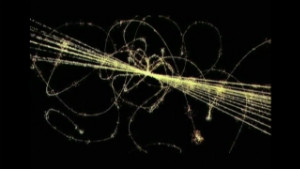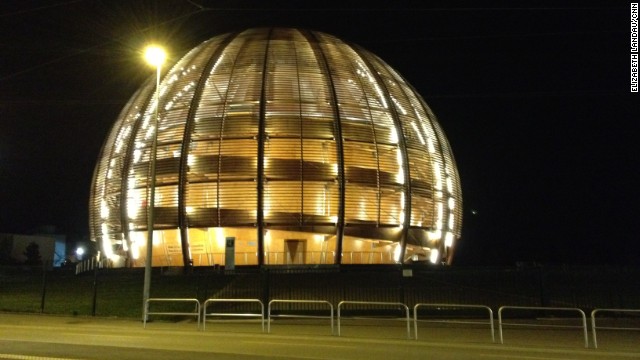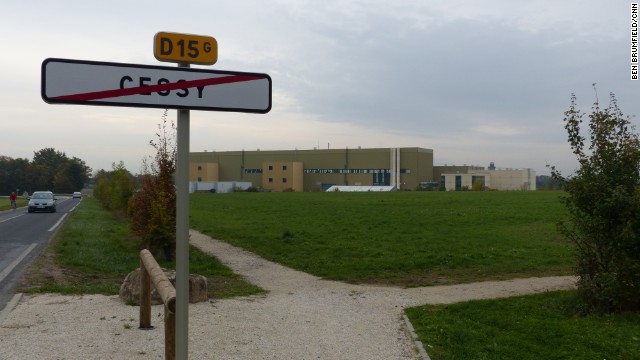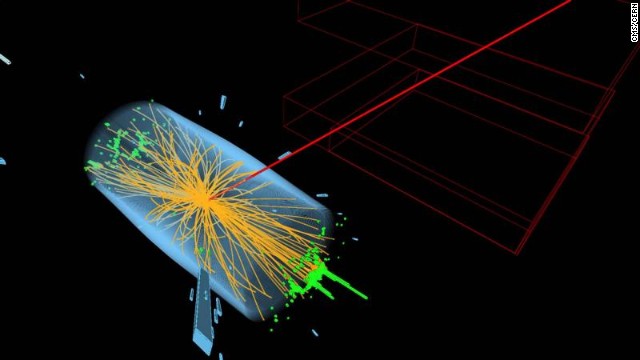Inside CERN's $10 billion collider
- The Large Hadron Collider will come back online in 2015
- Scientists are busy upgrading parts of the detector experiments
- CMS and ATLAS were the experiments that saw evidence of the Higgs boson
330 feet under Cessy, France (CNN) -- The biggest hazard for anyone lucky enough to see CMS, one of the major detector experiments deep underground at the Large Hadron Collider, is tripping.
"So watch where you step," physicist Joe Incandela said as we descended in an elevator 27 stories below the surface of the Earth.
In the event of a fire, take the elevator back up, he said -- a rule opposite from anywhere else. We also wore orange hard hats for the subterranean journey. You know, just in case.
From the cornfield beside the CMS buildings, against an idyllic mountain backdrop, you might not guess this is an entry point into the collider, the world's largest science experiment. The quiet winding roads through the French village of Cessy contrast with the subatomic violence of the particle accelerator below, which sends millions of protons smashing against each other every second.
We were able to go underground here thanks to a seven-year excavation of almost 250,000 cubic meters of soil and rock, a process that also uncovered a Roman villa nearby. That all led to the construction of a modern beige office complex on the surface, above the complicated particle detector that's waiting for us below.




CMS -- which stands for Compact Muon Solenoid -- sits along a 17-mile circular tunnel straddling the French-Swiss border. On the opposite side of the ring, in Switzerland, is ATLAS, another important experiment. Both projects are operated by the European Organization for Nuclear Research (CERN), the physics laboratory that hosts the collider.
CMS and ATLAS share the same scientific goals -- finding new particles and properties of the universe -- but their architecture and technical systems are different. Fabiola Gianotti, former spokeswoman for ATLAS, said there's a healthy competition between the groups that pushes both to do their best.
"I think we would not have produced so many beautiful results so quickly if this 'friendly competition' was not there," she said.
What is the Higgs boson and why is it important?
A $10 billion search for answers
The Higgs boson is a particle whose existence was confirmed at the Large Hadron Collider by both ATLAS and CMS in 2012. This year's Nobel Prize in Physics will be awarded to Francois Englert and Peter Higgs on Tuesday for their theories about this particle.
A simplified refresher on the idea: Throughout empty space is a phenomenon called the Higgs field, which is all around us. If this field gets excited, a tiny component will break off -- and that is the Higgs boson. This concept helps solve a fundamental question about the universe: Why does matter have mass?
That's one of the problems the collider experiments set out to explore. Adding to the mystique for the public -- but to the horror of scientists -- the Higgs boson took on the nickname "God particle"because of an eponymous book title (the author, physicist Leon Lederman, wrote that "Goddamn Particle" might have been more appropriate, but the publisher wouldn't allow it).
The accelerator started up on September 10, 2008, but after an electrical failure, particle collisions were delayed until late 2009. The hunt for the Higgs boson really took off in 2010, with the first high-energy particle collisions, ending the first "run" of protons smashing into protons in 2012.
After some lead-proton collisions in early 2013, the collider began its scheduled maintenance time in February. It's effectively turned off until 2015, but scientists at the accelerator -- it represents a $10 billion investment, excluding personnel -- are still pursuing their quest to figure out why the universe is the way it is. In other words, why we're here.
Facebook: CNNScience
Twitter: @CNNLightYears
The Higgs boson is part of our origin story. The collider has sought to recreate the conditions of less than a millionth of a second after the Big Bang, to look at how the universe evolved.
Physicists and technicians are hard at work upgrading the machinery so that the collider can ramp back up at unprecedented energies. They're also optimizing detectors for longer-term upgrades and exploring the uncharted seas of particle physics from the first collider run.
"This is one of the most busy times," Incandela said, "because we have to be thinking about things way out in the future while we're also analyzing all the data that we have from the past."
Making it better
The two-year shutdown allows for improvements the connections between magnets in the collider so that the twin beams of particles can race around at nearly twice the energy: as much as 13 trillion electron volts.
Some people have the impression that scientists at the collider can take a vacation now, said Andrew Lankford, professor at the University of California, Irvine, and former deputy spokesman for ATLAS. But the thousands of scientists at both ATLAS and CMS actually have a lot to do.
Both ATLAS and CMS will come back online with a whole range of improvements. Among them on ATLAS is the insertion of a "B layer," a new shell of detectors that should allow a more precise measurement of some Higgs particles decaying into other particles, said Dave Charlton, spokesman for the experiment. CMS, for which Incandela is the spokesman, is adding a muon detector layer to improve the detection of those particles, which are similar to electrons.
The collider's maintenance period is crucial because if something goes wrong when it's on, either with the accelerator or at any one of the experiments, everything may have to be shut down. All experiments will then miss out on collecting data until the problem can be solved.
"Everything is kind of tied together very closely," said Evaldas Juska, an engineer who is working on computers involved with CMS. "Everything has to be working for the process to take place."
Entering the deep frontiers of science
I'd wanted to see a particle detector since I started reporting on the collider in 2008, but I tried to be professional about my excitement as my ears popped on the elevator descent.
It's safe to approach the collider now because the beams are turned off. But what would happen if a person managed to get into the collider's tunnel during operations?
Death would be likely if you stood in front of the particle beams, Incandela said. And at these energies, if tens of millions of protons were colliding anywhere near where you were standing, even with a heavy detector in the way, you could sustain potentially serious damage.
Fortunately, security is top-notch -- including a retinal scan -- and sweeps of the area are conducted to make sure there's no one in the tunnel before starting the beams, Incandela said. There are particular alarms that sound when a beam is about to begin.
"In fact, if you try to enter the cavern when the beam is running, the act of opening the door would trigger an immediate beam abort." Incandela said. "By the time you got the through the door, there would probably be no beam in the machine."
As we descend, Incandela tells us that if we hear any alarms, they won't be fake. But the elevator is isolated. There's air pumped into the column, and it has a separate power system, so it's actually a good mode of escape from a fire.
The doors open, and the buzzing sound of fans for cooling the unfathomable amount of electronics rushes in.
"OK. We're down now," Incandela said.
Where it all happens
One of our first stops was a long corridor with aisles of computing equipment in blue casings. No people have been obliterated inside the Large Hadron Collider, but these are delicate systems set up to get rid of data overload. At CMS, it takes much of three stories of electronics to help decide which particle collisions scientists will study.
Why? It's impossible to keep the data about all of the particle collisions -- tens to hundreds of million per second -- so the computers quickly choose 100,000 events per second and then feed that data to a "farm" of processors to whittle it down to 500 to 1,000.
Running this process, called "the trigger," is a tough job: What if something important gets lost in the filtering?
"I see those guys during the run, and they're stressed out for a long time," Incandela said.
Noise from the fans intensifies when we enter an elevated platform in the detector's lair. These days, the experiment is separated into multiple layers so individual components can get serviced. The nearly 14,000 tons of machinery can slide back together, air-hockey style, when high-pressure air is pumped into large circular pads at the base of each major section.
Looking over the green railing, I saw -- but couldn't hear -- a blonde woman in a hard hat sweeping the floor. Her small stature, relative to the detector pieces, gave me a sense of how massive the experiment really is.
CMS is about the size of a four-story apartment building -- 49 feet high -- with its components designed precisely to a thousandth of an inch. (ATLAS is even taller, at 82 feet.) The complex array of instruments includes about 100 million channels of electronics, all synchronized to a billionth of a second.
Bulging out from one slice is a black and silver endcap, which holds some of the experiment's 76,000 lead-tungstate crystals.
Another roundish layer of CMS is covered in mostly red and silver panels, but blue and red cables are slithering all around it. This is one of the magnet barrel rings, where the red directs the magnetic field and the silver rectangles are muon detection chambers.
The operation's core ingredient is large silver circular ring, the world's most powerful superconducting solenoid magnet. Inside it is an intricate tracking system made of silicon that measures the trajectory of particles without interrupting them.
In the 17-mile circular tunnel there are seven experiments:
ATLAS
What: General-purpose detector experiment
What it studies: Looks for new particles and physics
Weight: about 7,700 tons
Dimensions: 150 x 82 x 82 feet
CMS
What: General purpose detector experiment
What it studies: Looks for new particles and physics
Weight: Nearly 14,000 tons
Dimensions: 69 x 49 x 49 feet
ALICE
What: Specialized detector (lead-ion collisions)
What it studies: Measures properties of quark-gluon plasma
Weight: About 11,000 tons
Dimensions: 85 x 52 x 52 feet
LHCb
What: Specialized detector (B-particle interactions)
What it studies: Looks for matter/antimatter asymmetries
Weight: About 6,200 tons
Dimensions: 69 x 33 x 43 feet
LHCf
What: 2 small specialized detectors near ATLAS
What it studies: Helps to estimate energy of cosmic rays
Weight: 88 pounds each
Dimensions 1 x 0.3 x 0.3 feet each
TOTEM
What: Specialized detectors in vacuum chambers, near CMS
What it studies: Measures size of the proton, luminosity of collisions
Weight: 22 tons
Dimensions: 1,443 x 16 x 16 feet (total)
MOEDAL
What: Specialized detector spanning 400 units, near LHCb
What it studies: Looks for a magnetic monopole
Dimensions: Total area is 2,691 square feet
During the shutdown, Ph.D.-level physicists work hands-on at CMS, wrenches and all, Incandela said, but most of the critical work is done by technicians. For instance, technicians are adding cooling lines that will be used for a system that will be put in place in two or three years. We saw a man in a white hard hat on a cherry picker, using a long wand-like tool, who is probably working on that.
"When the machine is off, it's like airplanes when they're grounded. You're losing time; you're losing money," Incandela said. "So we're trying all the time to optimize our use of these down times."
Incandela sounded like a proud parent as he gestured toward CMS components that came from different countries. There's iron from Germany, colored red, but also from China. Little orange cylinders, determining where the detectors mount, came from Serbia. There's green armature from Yorkshire, England. Small silver chambers came from Italy.
"Everywhere you point there's something from somewhere, you know, different," he said. "And what's great is that it all came together; it all fit perfectly."
There are 42 countries represented in the CMS collaboration and as many as 4,000 scientists.
When you think about how much brainpower and time went into designing and building this structure, Incandela said, "It's really a modern cathedral." (Not because anyone is worshiping a God particle, of course.)
What else is there to find?
In July 2012, scientists at CMS and ATLAS had accumulated enough data about particle collision events that looked like Higgs bosons decaying that they could say at last: It's real.
But there's lots more to learn about the Higgs, and more information about it could be lurking in data from the first collider run.
Some data still need to be, in physicist lingo, "unblinded." To avoid bias, physicists don't closely examine data that may correspond to a discovery until they're sure they understand all of the other results from the background. In other words, they don't do more tweaks and rigorous analysis of the most interesting data regions -- for instance, the Higgs boson -- until they have thoroughly explored the rest first.
"It's a bit like opening a present now, since we know there is something in it," Incandela said. "Before the discovery, it was not certain that the 'box' was not empty."
New discoveries are still happening. Recently both ATLAS and CMSreleased new evidence about the Higgs boson's properties. They each showed strong evidence of Higgs particles decaying into fermions, which are components of matter. (But the Higgs particle is not stable; once created, it quickly decays into other small building blocks of our universe).
This is significant because previously, when the Higgs was discovered, the detectors captured it decaying into particles called bosons, which carry fundamental forces.
That means, at last, the Higgs boson has been observed giving rise to matter particles and at a rate consistent predicted by the Standard Model of Physics, the leading explanation for how the universe works.
In other words, the Higgs is capable of creating matter with mass.
Scientists are also looking for a whole other array of particles predicted by a theory called supersymmetry. The idea is that every particle we know has a supersymmetric partner, which would explain some of the gaps in our understanding of the universe.
"I think supersymmetry has to be there," Incandela said. "It's not something kind of wacky that we just made up."
Also tantalizing would be if scientists find evidence of dark matter. The stuff we see is made up of particles that are only 5% of matter in the universe; the other 95% matter is dark matter, and it has never been detected.
How particle smasher and telescopes relate
All this is to say that finding the Higgs boson didn't solve everything. Because of the particular mass of the Higgs at 125 gigaelectron volts, it actually raises new problems.
"The only way you cleanly solve those problems is with a new array of particles, things like a mirror image of the existing particles, like another dimension of the universe," Incandela said. "And in that realm we have many good candidates for the dark matter. And they can't be too far away in energy."
Just beyond our reach
There could be much more than just one particle in this untapped dark matter realm, Incandela said as we rode the elevator back up. After all, it would be ridiculous to assume that our universe is made of just one particle.
Dark matter could even be something that we can access one day. We don't know what we could do with it or what technologies might develop, "but it would certainly help us understand the universe a lot better."
It may take an even more powerful machine than the Large Hadron Collider to find out. Discussions are in the works about a next-generation accelerator, the International Linear Collider, which could make even more precise measurements about components of our universe we know little about.
The elevator door opened, back at the surface in France. Incandela looked at me expectantly: "You don't get to keep the helmet."
I laughed and relinquished the orange hat, marking the end of my journey.
But for the scientists at the Large Hadron Collider, the exploration continues, accelerating knowledge.
Elizabeth Landau is on Twitter at @lizlandau. For more CNN science news follow @CNNLightYears.
- MCAT Question of the Day Solution! Thermodynamics The Med School Pulse
- Realistic Pilot Training with No Plane The Boeing Company
- The Ultimate Deep Diver The Boeing Company




No comments:
Post a Comment